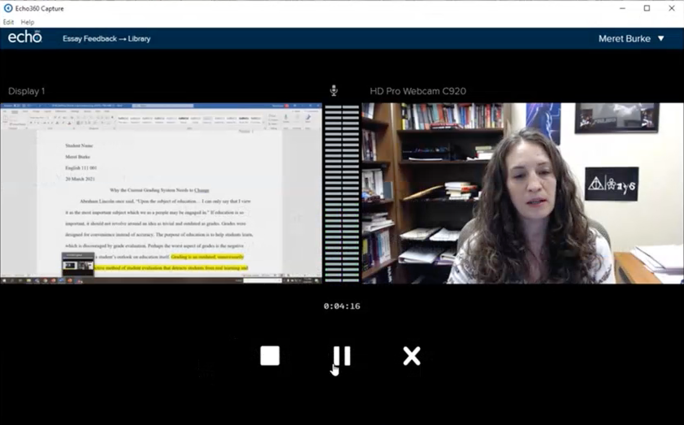How One Instructor Uses Echo360 to Engage and Assess Students

Click here to see the feedback video.
I began using Echo360 several years ago as a teaching tool in my online courses. Initially, I used Echo360 to record short videos for my classes to help create a sense of social presence, provide personalized tutorials, and connect course concepts from one week to the next. At that time, I was one of a handful of instructors at my institution using Echo360 consistently in my online courses, and student response was overwhelmingly enthusiastic. Students frequently reached out to me to thank me for posting the videos and the use of instructional video was one of the most prominent elements of feedback collected from end of course surveys. In the early semesters, my use of Echo360 was limited to recording and posting a series of short videos each week, and even with that limited use, I recognized that desktop capture videos were a game changer in the online teaching space. Since I teach composition and structure my classes in a workshop style, I don’t use Echo360 in my face-to-face teaching, but I do rely heavily on the platform in my online and hybrid courses and I utilize Echo360 video, engagement tools, and analytics in the course Moodle content to enhance my face-to-face classes.
Boost Student Engagement with A Blend of Interactive Media
Since those first few semesters, the use of Echo360 videos in my online courses has expanded. In addition to the desktop capture videos, I now integrate many of the advanced features available in Echo360 to encourage student engagement and metacognition. Equally important, the engagement tools allow for a streamlined system of collecting formative feedback. I blend features of popular Classroom Assessment Techniques (CATs), such as one sentence summaries and muddiest points with the polling features of Echo360. The videos and engagement tools allow me to quickly collect and review feedback. I now include slide decks, embedded polls, multimedia slides, Q&A prompts, and encourage students to use the confusion flags and post questions within videos. This also creates a more active learning environment for the students; rather than being passive viewers, they are asked to think about the concepts and apply them in real time as they respond to polls and justify their responses. As I review student responses, it only takes a few minutes to note whether students are gaining the concepts and skills my instruction is aiming for so I can adjust as needed. I typically review the data at the class level overall, but the analytics are also helpful when reviewed at the individual student level. I can quickly identify less engaged students or students who may be struggling with course concepts.
Provide Feedback with Echo360 Video
Something I’ve started doing more recently is providing students with Echo360 video feedback in my online composition courses. I do this at the class level as well as the individual student level. For whole class feedback, I’ve started debriefing discussion forums. I create highlight slides to bring attention to a handful of student comments that were particularly insightful. I use this opportunity to reinforce the learning outcomes for the forum and situate the conversation within the broader course context. It also helps students see the importance of their discussion forums in achieving the learning outcomes for the course.
For individual students, I use Echo360 to record and send students a short feedback video to review some highlights of their finished essays. I typically use these videos to reinforce improvements in student writing over time. As we work with multiple drafts of student writing, it’s easy for students to feel discouraged or lose sight of how much progress they’ve made from one draft to the next. Best practices in writing feedback stress that extensive in-line comments are not helpful for students, particularly at the final grading stage. Rather than spend time marking final essays, I’ve started providing a short paragraph of summary comments or a summary feedback video using Echo360. My goal is to provide video feedback for each student one time per semester, although ideally, I would like to be able to provide students with video feedback for all major writing projects in the course. It does take time to create videos and share with individual students, but when I consider how much time I used to spend marking and writing on student essays, I am probably saving time overall.
Finally, I ask students to respond to their feedback in a reflective writing assignment at the conclusion of every major project. In these writing reflections, students have responded favorably to the videos and have asked for more of this kind of feedback. While this strategy is still new to me, I’m exploring the idea of utilizing a shared folder with each student as a simplified way to share videos with students.
Meet the Author:

Make sure to check out her upcoming webinar:
“More Options for Engaging and Assessing Students”
held on Wednesday, 28 July at 9:00 AM AWST (11:00 AM AEST and 1:00 PM NZST).
Click here to read more and register for the session.
From campus video management, lecture capture, online and hybrid learning, and more, contact us to discover how Echo360 can help transform the teaching and learning experience at your institution.

